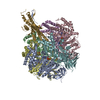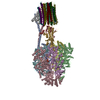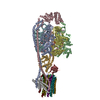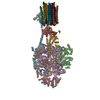+Search query
-Structure paper
| Title | Structural Elements Involved in ATP Hydrolysis Inhibition and ATP Synthesis of Tuberculosis and Nontuberculous Mycobacterial F-ATP Synthase Decipher New Targets for Inhibitors. |
|---|---|
| Journal, issue, pages | Antimicrob Agents Chemother, Vol. 66, Issue 12, Page e0105622, Year 2022 |
| Publish date | Dec 20, 2022 |
 Authors Authors | Chui Fann Wong / Wuan-Geok Saw / Sandip Basak / Mio Sano / Hiroshi Ueno / Hwee Wen Kerk / Dennis Litty / Priya Ragunathan / Thomas Dick / Volker Müller / Hiroyuki Noji / Gerhard Grüber /     |
| PubMed Abstract | The FF-ATP synthase is required for the viability of tuberculosis (TB) and nontuberculous mycobacteria (NTM) and has been validated as a drug target. Here, we present the cryo-EM structures of the ...The FF-ATP synthase is required for the viability of tuberculosis (TB) and nontuberculous mycobacteria (NTM) and has been validated as a drug target. Here, we present the cryo-EM structures of the Mycobacterium smegmatis F-ATPase and the FF-ATP synthase with different nucleotide occupation within the catalytic sites and visualize critical elements for latent ATP hydrolysis and efficient ATP synthesis. Mutational studies reveal that the extended C-terminal domain (αCTD) of subunit α is the main element for the self-inhibition mechanism of ATP hydrolysis for TB and NTM bacteria. Rotational studies indicate that the transition between the inhibition state by the αCTD and the active state is a rapid process. We demonstrate that the unique mycobacterial γ-loop and subunit δ are critical elements required for ATP formation. The data underline that these mycobacterium-specific elements of α, γ, and δ are attractive targets, providing a platform for the discovery of species-specific inhibitors. |
 External links External links |  Antimicrob Agents Chemother / Antimicrob Agents Chemother /  PubMed:36445139 / PubMed:36445139 /  PubMed Central PubMed Central |
| Methods | EM (single particle) |
| Resolution | 3.5 - 7.3 Å |
| Structure data | EMDB-33614, PDB-7y5a: EMDB-33615, PDB-7y5b: EMDB-33616, PDB-7y5c: EMDB-33617, PDB-7y5d: |
| Chemicals |  ChemComp-ATP:  ChemComp-MG:  ChemComp-ADP: |
| Source |
|
 Keywords Keywords | HYDROLASE / Complex / F-ATP synthase / cryo-EM / mycobacteria |
 Movie
Movie Controller
Controller Structure viewers
Structure viewers About Yorodumi Papers
About Yorodumi Papers











 mycolicibacterium smegmatis (bacteria)
mycolicibacterium smegmatis (bacteria)